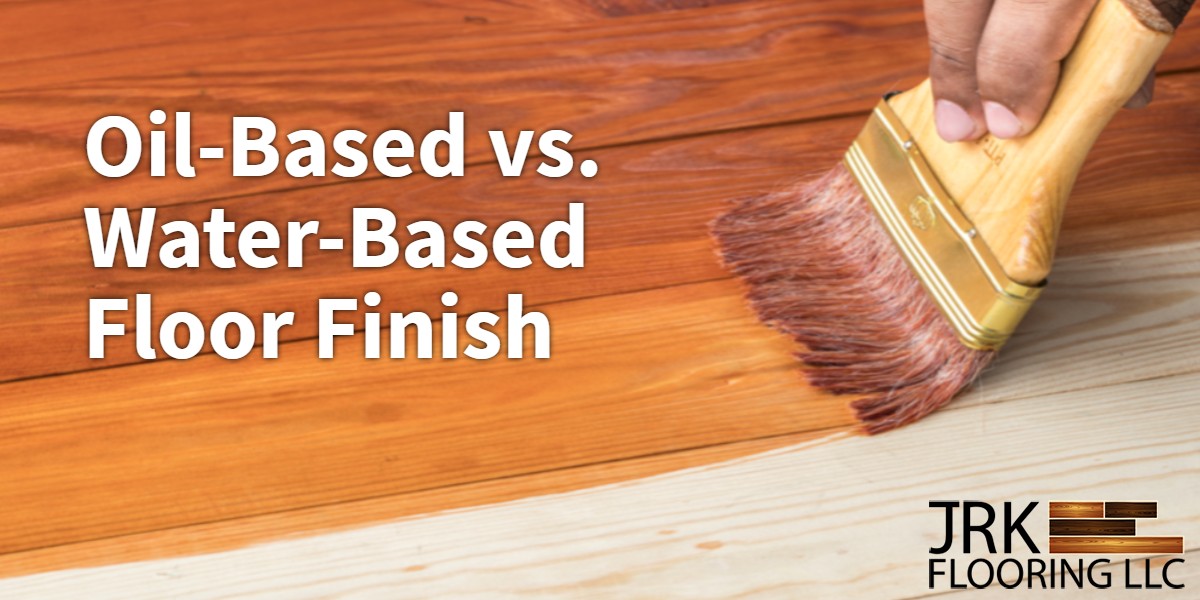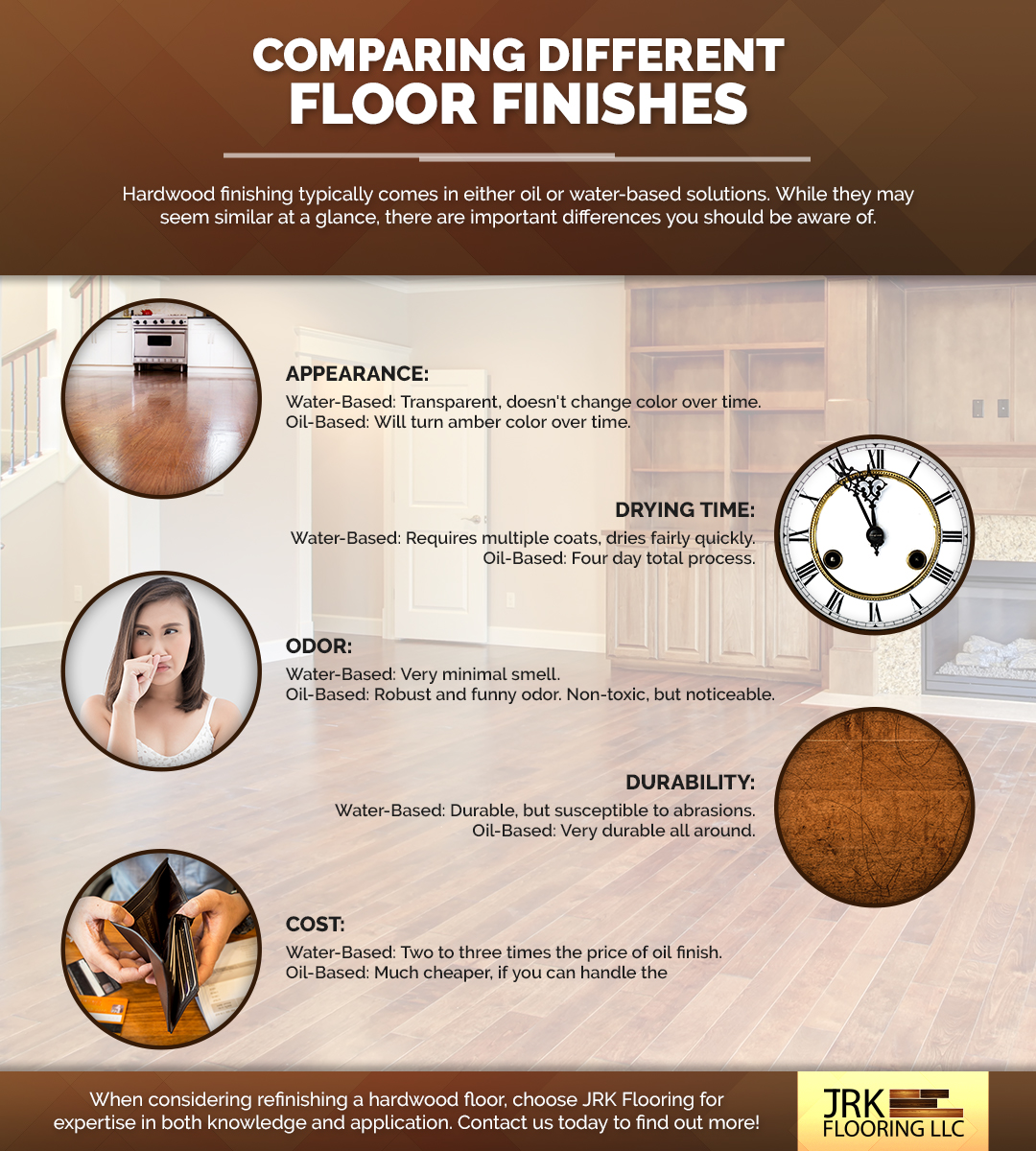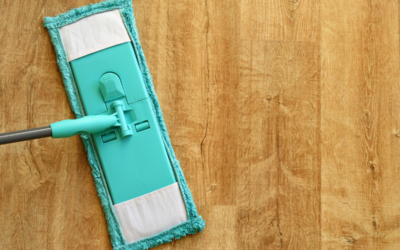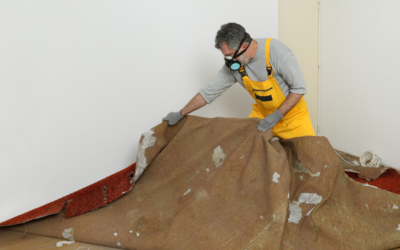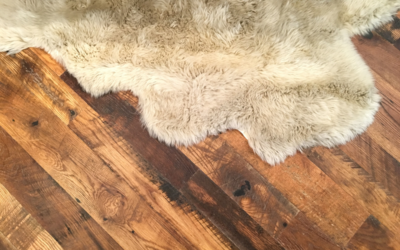Choosing the right finish for your hardwood floors can be pivotal in achieving the desired look and longevity. At JRK Flooring, we understand the importance of making an informed decision between oil-based and water-based polyurethane finishes. This guide provides a detailed comparison to help you select the best option for your flooring project.
What are the Differences Between Water-Based and Oil-Based Polyurethane Finishes?
The main difference lies in their composition. Water-based polyurethane is a combination of acrylic and polyurethane that uses water as a solvent, while oil-based polyurethane contains synthetic resins and linseed oil, using a petroleum-based solvent.
Key Characteristics of Water-Based Polyurethane
- Quick Drying Time: Water-based polyurethane dries faster than oil-based.
- Low Odor and VOCs: It emits fewer volatile organic compounds (VOCs) and has a less potent odor.
- Clear Finish: Tends to retain a clear finish, affecting the wood’s color minimally.
- Ease of Application: Generally easier to apply, with quicker recoat times.
Key Characteristics of Oil-Based Polyurethane
- Rich, Amber Finish: Provides a warm, amber glow to the wood.
- Durability: Known for its robust and long-lasting finish.
- Slower Drying Time: Takes longer to dry, which can be beneficial for a smoother finish.
- Higher VOCs and Odor: Emits more fumes and has a stronger odor compared to water-based options.
Durability Comparison Between Water-Based and Oil-Based Polyurethane Finishes
While both finishes offer good durability, oil-based polyurethane generally provides a tougher layer that is more resistant to scratches and general wear. Water-based polyurethane, though not as robust as its oil-based counterpart, still offers a resilient finish suitable for most homes.
Application and Drying Time Differences
Oil-based polyurethane takes longer to dry, often needing 24 hours between coats, whereas water-based polyurethane can dry within a few hours, allowing multiple coats to be applied in a single day.
Comparing the Odor and VOC Levels of Water-Based and Oil-Based Polyurethane
Water-based polyurethane is known for its low VOC content and minimal odor, making it a preferable option in homes with children, pets, or sensitive individuals. Oil-based polyurethane, with its higher VOC levels and strong odor, requires more ventilation during application.
Which Type of Polyurethane Finish is Best for Hardwood Floors?
Selecting the best polyurethane finish depends on several factors, including the floor’s usage, desired aesthetic, and maintenance level. Water-based polyurethanes are ideal for a contemporary look and faster drying times, while oil-based polyurethanes are suited for a traditional, rich finish and high durability.
Considering the Natural Color and Grain of Hardwood Floors
- Water-Based Polyurethane: Enhances the natural color and grain of the wood without adding much coloration, making it ideal for lighter woods.
- Oil-Based Polyurethane: Adds warmth and deepens the color of the wood, which can be beneficial for darker, richer woods.
Scratch Resistance and Durability of Different Polyurethane Finishes

- Oil-Based Polyurethane: Known for its tough finish, it offers excellent resistance to scratches and general wear, making it suitable for high-traffic areas.
- Water-Based Polyurethane: Provides good durability with a harder finish, though it may require more frequent touch-ups in heavily used areas.
Impact of Different Finishes on the Aging and Darkening of Wood Floors
- Water-Based Polyurethane: Minimally impacts the aging of wood floors, maintaining the wood’s original color over time.
- Oil-Based Polyurethane: Tends to amber or darken the wood over time, giving it a rich, aged patina.
Examining the Drying Characteristics and Clarity of Water-Based and Oil-Based Finishes
- Water-Based Polyurethane: Known for its fast drying time and clear finish, it’s ideal for projects with tight timelines and where retaining the wood’s natural color is essential.
- Oil-Based Polyurethane: Requires a longer drying time, which can be beneficial for achieving a smooth, self-leveling finish; however, it imparts an amber tint to the wood.
Choosing the Appropriate Finish Based on the Type of Wood Used for the Flooring
- Harder Woods: Can be finished with either type of polyurethane, though water-based finishes are better at highlighting the natural color and grain.
- Softer Woods: Often benefit from the thicker, more protective layer of oil-based polyurethane, which can help mask imperfections and provide added durability.
How to Apply Water-Based and Oil-Based Polyurethane Finishes
Steps for Preparing the Hardwood Floor for Water-Based Polyurethane Application
- Clean the Floor: Remove all dust, dirt, and debris.
- Sanding: Sand the floor smoothly, starting with a coarser grit and moving to finer grits.
- Vacuum and Tack Cloth: Thoroughly vacuum the floor and then wipe it down with a tack cloth to remove any remaining dust.
Steps for Preparing the Hardwood Floor for Oil-Based Polyurethane Application
- Deep Cleaning: Ensure the floor is completely free of any residue and dirt.
- Sanding: Similar to water-based preparation, but pay extra attention to any uneven areas, as oil-based finishes highlight imperfections more.
- Dust Removal: Use a vacuum followed by a tack cloth to ensure a completely clean surface.
Application and Drying Considerations for Water-Based Polyurethane
- Application Technique: Use a synthetic brush or a foam roller for application. Apply thin, even coats.
- Drying Time: Water-based polyurethane dries quickly, often in 2–4 hours. However, wait for 24 hours before applying the next coat for best results.
Application and Drying Considerations for Oil-Based Polyurethane
- Application Technique: Apply with a natural bristle brush. Be mindful of drips and brush marks, as oil-based finishes are thicker.
- Drying Time: Oil-based finishes take longer to dry. Allow at least 24 hours between coats. Ensure good ventilation to aid in drying and reduce odor.
Guidelines for Applying Additional Coats and Sealers with Both Types of Polyurethane Finishes
- Additional Coats: Generally, three coats are recommended for both types of finishes. Lightly sand between coats using fine-grit sandpaper for better adhesion.
- Sealers: For water-based polyurethane, a sealer isn’t always necessary. However, for oil-based, a sanding sealer can be used before the final finish to ensure an even, smooth coat.
- Final Coat: Apply the final coat carefully, ensuring a smooth, even application. Avoid heavy application to prevent drips or bubbles.
When choosing between water-based and oil-based polyurethane finishes, consider your specific needs, the type of wood, and the desired appearance of your floors. Both finishes have their advantages, and the right choice depends on your individual circumstances and preferences.
Factors to Consider in the Decision Between Oil-Based and Water-Based Polyurethane Finishes
Choosing the right polyurethane finish involves considering several factors:
- Room Usage: High-traffic areas may benefit from the durability of oil-based finishes.
- Aesthetic Preference: The choice between a rich, amber finish (oil-based) and a clear, natural look (water-based).
- Drying Time: Consider your timeline. Water-based polyurethane dries faster, which can be crucial in time-sensitive projects.
- Health and Environmental Concerns: Water-based polyurethane is low in VOCs and odor, making it a healthier choice, especially in homes with children or pets.
Comparing the Environmental Impact of Water-Based and Oil-Based Polyurethane Finishes
- Water-Based Polyurethane: Offers a more environmentally friendly option with lower VOC emissions and less odor.
- Oil-Based Polyurethane: Higher in VOCs, requiring more ventilation and potentially impacting indoor air quality.
Financial Considerations and Cost Differences Between the Two Types of Finishes
- Initial Cost: Water-based polyurethane typically costs more per gallon than oil-based.
- Long-Term Investment: Consider the longevity and maintenance requirements. Oil-based finishes may require fewer touch-ups over time.
Understanding the Impact of Color and Ambering on the Choice Between the Polyurethane Finishes
- Color Retention: Water-based polyurethane maintains the wood’s natural color better than oil-based, which adds an amber hue that deepens over time.
- Aesthetic Changes: The choice may depend on whether you prefer the natural aging process of wood or wish to maintain its original color.
Determining the Level of Maintenance and Ease of Repair for Each Type of Finish
- Water-Based Polyurethane: Easier to repair, but may require more maintenance over time.
- Oil-Based Polyurethane: Generally requires less frequent maintenance, but can be more challenging to repair due to its thicker nature and tendency to amber.
Examining the Long-Term Impact of UV Exposure on Water-Based and Oil-Based Polyurethane Finishes
- UV Resistance: Water-based finishes typically offer better resistance to UV light, preventing yellowing and maintaining clarity over time.
- Age-Related Changes: Oil-based finishes will amber and darken with exposure to sunlight, which can be desirable for a warmer, aged look.
Conclusion: Making the Right Choice for Your Hardwood Floors
Whether doing DIY hardwood floor refinishing or working with a professional like JRK Flooring, the decision between oil-based and water-based polyurethane is crucial for finding the right balance for your specific needs and vision. As we’ve explored in this guide, both types of finishes have their unique strengths and considerations.
Oil-based polyurethane, with its rich, amber glow, brings out the depth and warmth in hardwood floors, making it a timeless choice for traditional aesthetics. Its durability makes it a wise choice for high-traffic areas, though it requires patience with longer drying times and consideration for its higher VOC levels.
On the other hand, water-based polyurethane offers a clear, quick-drying finish that preserves the natural color of the wood, making it ideal for contemporary spaces and projects with tight deadlines. Its low odor and VOC content also make it a health-conscious choice for homes with children and pets.
When choosing the right finish, consider the room’s usage, the hardwood’s natural color and grain, and the desired maintenance level. Moreover, weigh the environmental impact, cost differences, and the long-term effects of UV exposure on the finish.
At JRK Flooring in Kansas City, we are dedicated to helping you navigate these decisions, ensuring that your hardwood floors enhance the beauty of your home and reflect your personal style and meet your practical needs. Whether you opt for the robustness of oil-based polyurethane or the clarity and eco-friendliness of water-based polyurethane, our team is here to support you in achieving stunning and lasting results. Remember, the right finish can transform your hardwood floors into a lasting piece of beauty in your home.



